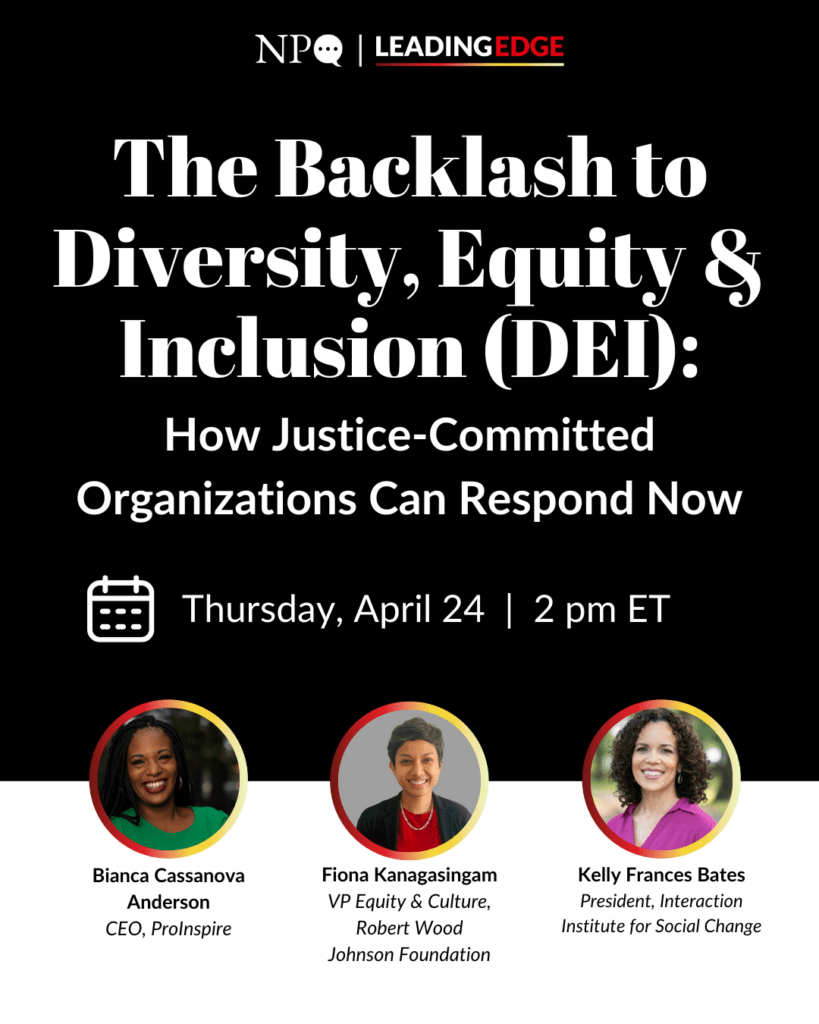For U.S. nonprofit fundraisers, the release of the Giving USA numbers is a much-anticipated annual event. Published each June, this roundup of giving during the prior year offers a sense of the trends in philanthropy. The overview helps organizations understand their revenue environment, at least as far as philanthropic dollars are concerned.
But Giving USA often gets questions on how we derive our numbers. This article lays out our process and addresses several frequently asked questions and new developments. While portions of this discussion may be of interest only to fundraising wonks and academics, we get these questions often. Since so many organizations depend on our projections for guidance, we want to provide you with the details on how we arrive at these numbers.
First, here are some basic facts about how Giving USA treats the data:
Giving USA includes gifts in-kind and cash gifts from individuals, corporations, and estates, plus foundation grants. Because it counts only philanthropic gifts, it doesn’t include amounts that United Ways distribute or government grants or contracts, although these dollar amounts are also important to charity budgets.
Giving USA develops and then revises estimates as new data is released by government agencies and other sources. The main data source is returns filed with the IRS, but we also use survey data for some household giving as well as publicly available information about giving to religion.
Money Given to and by Foundations
Giving USA uses the Foundation Center’s estimates for foundation grantmaking. But we move the Foundation Center’s estimate for corporate foundation giving to corporate giving, and we report private, community, and operating foundation results in the foundations “pie slice.”
As more foundations form and as donations from bequests and living donors are added to existing foundations, foundation giving as a share of the sources of giving has grown.
In the foundation world, another important change has taken place. An increasing percentage of foundations are spending down their total assets, making grants from assets (or previously donated money), not just from investment earnings (new money for philanthropy). Giving USA works with the Foundation Center to find reliable methods for adjusting for this, especially as we expect the trend to accelerate with the new Giving Pledge announced in mid-2010 by Warren Buffett, Bill and Melinda Gates, and at least 40 of their peers.
Historically, foundations have made grants from interest earned on invested funds, so Giving USA reports foundation grants as “new money” for charitable organizations. With developments such as the recent Giving Pledge, an increase in the number of foundations that are spending down their assets, and other shifts in recent years, Giving USA and the Foundation Center have established new methods of tracking foundation giving to ensure that we avoid double counting.
Where data is available, Giving USA avoids double counting. Warren Buffett’s annual gift to the Bill & Melinda Gates Foundation, for example, is not counted as an individual gift to a foundation because Buffett stipulates that the money must be granted out annually instead of invested for future grantmaking. Giving USA tracks the Gates Foundation grant amount that includes funds distributed from Buffett’s contribution.
Where Does It All Go?
Giving USA tracks 10 types of recipients, or subsectors, and has an “unallocated” section, which includes allowed deductions that a charity does not report as revenue, such as license plate fees, volunteer miles, and gifts to public schools. Religion receives the largest share of the total, with one-third of the amount contributed.
Over time, Giving USA has added types of recipient charities to reflect changing priorities. In 1987, for example, international affairs organizations and environment- and animal-related organizations began to be tracked separately from public-society benefit. These groups are high-growth subsectors, whereas the arts and religion have grown comparatively slowly. The newest addition is foundation grants to individuals, which Giving USA began reporting in 2009. This category amount is based almost entirely on the market value of medications given by patient assistance foundations created by pharmaceutical manufacturers.
Giving USA uses IRS Form 990 data for receipts by type of charity. It can take up to two years for all IRS Form 990s to be available. So every two years, as data is released, Giving USA updates this information. We include estimates for organizations that are not required to file a Form 990 or Form 990-EZ.
Just as we review what is included, we also review methods for measuring giving to each subsector. With regular filing and release of IRS Form 990 data, we can now apply the same principles to estimate the types of recipients as we do to estimate the sources of giving. This makes for a long-awaited change in methods. In the past, Giving USA sent out a survey of organizations, which irritated at least some charities and was costly.
Because of a partnership with the National Center for Charitable Statistics at the Urban Institute, we no longer need to survey. Instead we use the historical record of IRS Form 990 data as filed by charitable organizations to estimate giving before the IRS data is available. We also supplement this data with other data sources. Giving USA also estimates receipts by small organizations that are not required to file a 990 because their revenue is less than the filing threshold.
But congregations and the governing bodies of religious groups (Catholic diocese, Lutheran synod, Presbyterian presbytery, Baptist association or convention, etc.) do not have to file 990s (although some choose to). So to estimate giving to religion, Giving USA tested three methods that came within 5 percent of one another. One method considers household giving to religious organizations, as found by the Center on Philanthropy Panel Study research project. Another method uses reported amounts received by about 120 religious organizations that share information publicly. The third approach uses annual changes from those 120 groups applied to a baseline year in Giving USA. Currently we use the third method because it includes donations from all sources.
When we count giving to religion or another subsector, we are interested in “new money” charitable contributions—not program service fees, government grants or contracts, or transfers from related organizations. In essence, Giving USA records the amounts that organizations receive that correspond to individual, corporate, and estate deduction levels—even if these donors do not deduct donations as charitable gifts—and to what foundations grant.
This approach works because the IRS Form 990 defines contributions nearly the same way that Giving USA views them: gifts, foundation grants, bequests, and corporate donations, including in-kind. In the future, we will watch and review some areas. Giving USA, for example, would like to remove gifts that charities give to other charities from its estimates. But the IRS Form 990 includes them as a contribution and there is no other data source. It would also help to show foundation grants made directly to recipients in other countries, which the Foundation Center reports after it analyzes grants made. For now, international grants are included in the “unallocated” section.
Giving Sources
Since Giving USA began in 1956, it has tracked the four sources of giving: individuals, bequests, corporations, and foundations. And individual giving has consistently been three-quarters or more of the total. We know this because the IRS has released regular tax return data about giving by each of the four sources we track.
Sign up for our free newsletters
Subscribe to NPQ's newsletters to have our top stories delivered directly to your inbox.
By signing up, you agree to our privacy policy and terms of use, and to receive messages from NPQ and our partners.
Giving USA measures items that the tax code permits donors to deduct on their tax returns. Cash gifts to religious organizations, registered charities, or governmental agencies and in-kind donations (whether of household goods, real estate, or personal property such as artwork or gemstones) all count.
If you itemize deductions on your taxes, you know the range of what’s included. As long as you keep good records, you can deduct an amount for mileage accrued in your work as a volunteer for a government or charity (including a congregation). If you pay a “fee” to the state to have a license plate that is tied to a state-run fund benefiting a charitable purpose (improving schools, preventing child abuse, an alma mater, etc.), you can take a charitable deduction. If you give to a public school, that counts, as does the money a gardener spends on soil, seeds, and peat pots for starting tomatoes and peppers for a nearby community garden, as long as it is run by a registered charity or government agency. Giving USA counts all these items as gifts.
Donated time can’t be deducted, nor, with some exceptions, can gifts made to nongovernmental organizations that are not registered as charities. So, when my sister-in-law pays her union dues or when my husband contributes old computer equipment to a startup urban tutoring group that hasn’t registered yet, these gifts are not deductible. The share of a gala ticket price that represents the market value of the meal is not deductible;? only a donated amount in excess of this market value can count as a gift.
Not all donors itemize deductions;? and not all donors (i.e., estates) are required to file tax returns. So, to ensure that giving by these individuals and estates gets counted, Giving USA estimates their giving and adds it to the IRS data for individuals and bequests. The estimate for non-itemizing households is based on an 8,000-household survey conducted every two years by the Center on Philanthropy at Indiana University in conjunction with the Panel Study of Income Dynamics. In a typical year, about 70 percent of households do not itemize deductions, and for 2009, Giving USA estimates that non-itemizing households gave an average $654 to charity. We use other survey data as part of the estimate for estates below the IRS filing threshold.
Data Estimates
So, you ask, if Giving USA relies on tax data, how do we create estimates in June for the year that just ended? There isn’t enough time for the IRS to analyze tax returns by June. You are right—we do not know yet what was claimed on 2009 tax returns. Instead, we use history as our guide.
Giving USA uses an established process that has been developed, tested, and reviewed. Each year two analysts independently follow the same process using the same data and compare results. When their results match, the 30-member Advisory Council on Methodology comprising respected economists and philanthropy scholars reviews the findings to ensure that the process was done correctly and to discuss the implications of the year’s results.
Giving USA’s process relies on historical IRS data to develop the estimates for both pie charts: the sources of giving and the uses (subsectors, or types of recipient) categories. The value estimates are derived by looking at the long-term relationship between giving and economic changes. So, for example, when personal income increases, we can project that giving will increase. Giving won’t necessarily increase as quickly as income, and countervailing forces such as stock market performance and tax rates may depress giving numbers. But in general, giving goes up in a fairly predictable way when income goes up, when the stock market goes up, or when tax rates increase.
The key takeaway is that, in any given year, fundraising observers may find it helpful to monitor the traditional factors known to influence giving: personal income at the Bureau of Economic Analysis (see www.bea.gov, which makes monthly announcements), the monthly close of the Standard & Poor’s 500, and changes in personal tax rates. In general, higher taxes mean higher giving for deductible gifts.
In a year or two, when tax data is released, estimates from Giving USA and others will be evaluated. Because we keep long-term trend information, Giving USA revises its estimates to reflect the IRS data, and we revise our methods periodically (which we will do for the 2011 edition) to see whether changes are needed. In 2001, for example, we tested whether the Consumer Confidence Index was related to changes in giving. At that time, it was not. With several more years of giving data aggregated since that time and dramatic changes in our economy, we might find in this year’s test that measures on the Consumer Confidence Index can anticipate what people claim as itemized charitable deductions on tax returns.
Gift Availability for the “Average Charity”
One of Giving USA’s goals is to provide information that can help nonprofit organizations understand where the charity “marketplace” is most active. Over the past few months, many people have asked, “How much money is there really for our type of charity?” In an early 2011 issue of its Spotlight newsletter, Giving USA will tackle this topic. We will review the allocation by type of recipient after we remove gifts that are restricted in purpose (endowment) or type of recipient (giving to foundations) and, thus, are not available for operating expenses or other current needs. Where data is available, we will also adjust for in-kind donations.
In 2008, gifts to foundations were $33.7 billion, for example, which at the time of this writing is the most recent year with a complete estimate. In the future, these foundations will make grants to benefit charities, but even in 2009, little of this money reached organizations that meet societal needs. In addition, in 2008, $14.5 billion went for capital purposes (buildings and endowments) at higher-educational institutions and about $400 million went to endowment funds in health-care organizations. In the long run, endowment funds help sustain important activities. But these monies are not available now to keep the lights on and the doors open.
On another note, Giving USA reports all charitable contributions without considering the purpose of the gift. After removing gifts to religion and restricted gifts, further analysis shows that the amount initially available to “average secular charities” is not $303 billion, but closer to $150 billion.
If you exclude religion giving from consideration and the endowment, capital, and in-kind gifts that can be documented from individuals and corporations, Giving USA estimates that in 2008, there was just more than $100 billion distributed in cash and securities to organizations in the other subsectors, from education and human services to international affairs and environment/?animals (see figure 1 on page 41). Of that amount, about $4 billion went to United Way (in public-society benefit) and was then allocated to other kinds of charities—largely human services, health, and education programs.
Giving Trends for Organizational Planning
The bottom line is that Giving USA uses reliable and verifiable methods to provide trend data and annual information to educate your board and staff;? to draw on in your communications and planning;? and to consult to find potential opportunities.
Tracking trends and watching for opportunities are part of the challenges and joys of nonprofit fundraising. Giving USA is a handy guide to shifting priorities in the nonprofit sector. We will always strive to provide the timely and useful knowledge about charitable giving that has characterized Giving USA for more than 55 years.
About the Author
Melissa S. Brown has been the managing editor of Giving USA since 2001.












